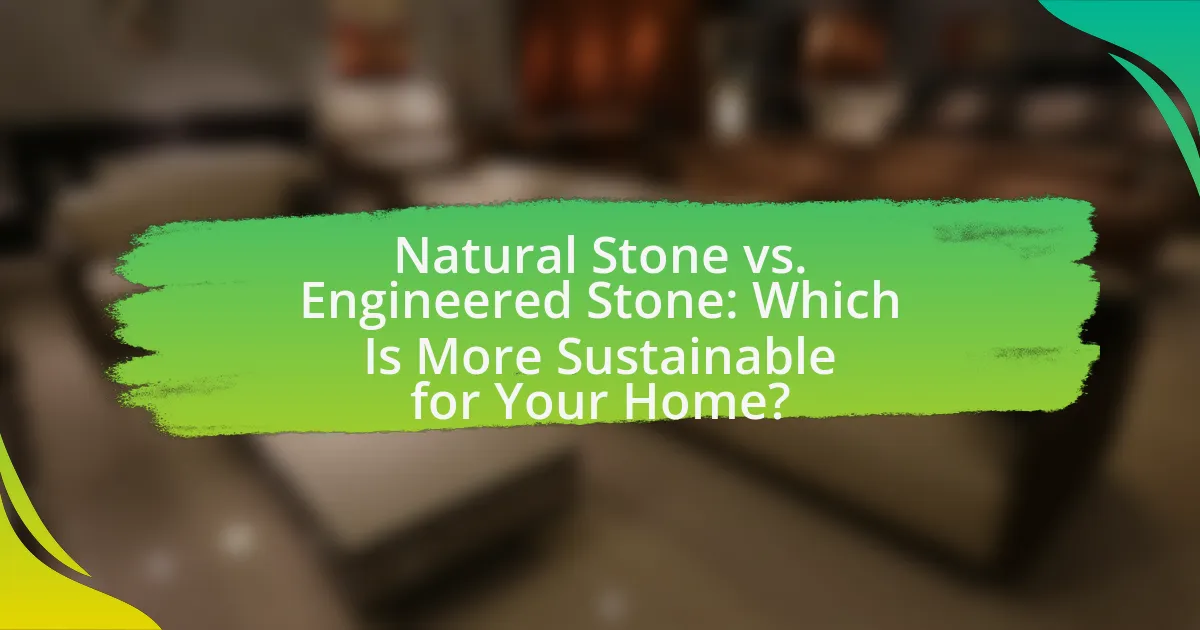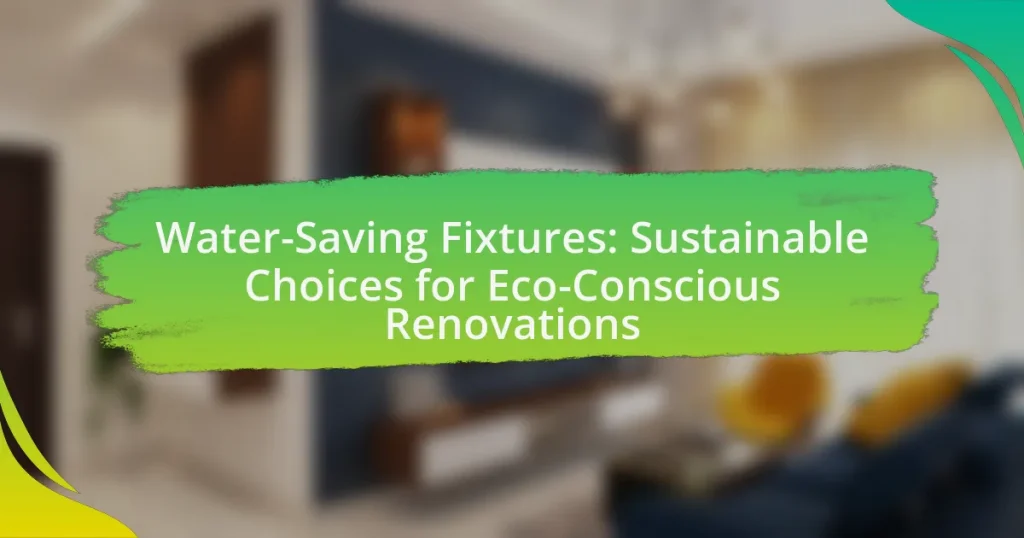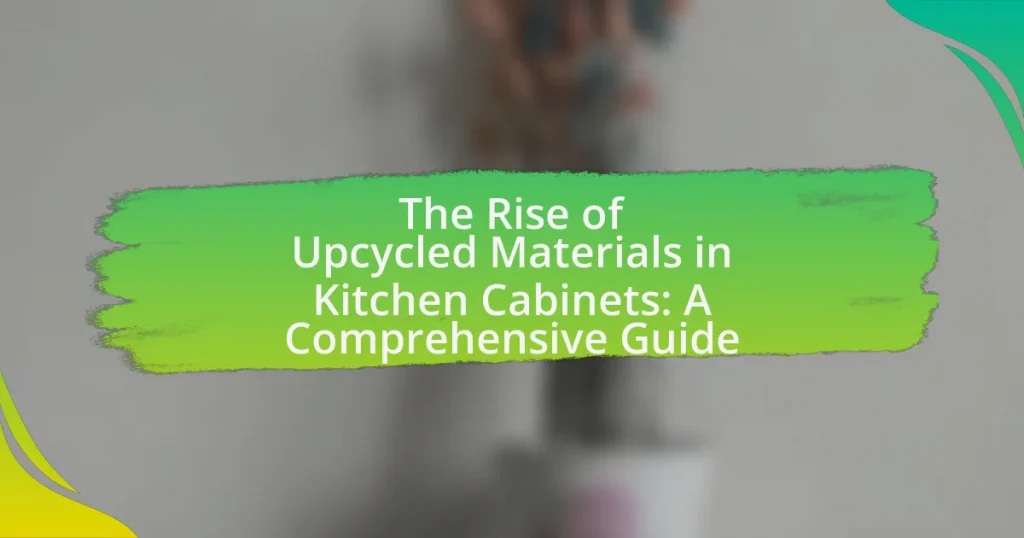Natural stone and engineered stone are two popular materials used in home construction and design, each with distinct characteristics and environmental impacts. Natural stone, sourced directly from quarries, is a naturally occurring material that includes granite, marble, and limestone, while engineered stone is a man-made product created by combining natural stone aggregates with resins and polymers. The article explores the sourcing and production processes of both materials, their environmental impacts, sustainability considerations, and key differences in durability, maintenance, and aesthetics. It also discusses best practices for selecting and maintaining sustainable stone options for home use, providing insights into the life cycle and carbon footprints of each material.
What are Natural Stone and Engineered Stone?

Natural stone is a naturally occurring material, formed through geological processes over millions of years, and includes types such as granite, marble, and limestone. Engineered stone, on the other hand, is a man-made product created by combining natural stone aggregates with resins and polymers, resulting in a durable surface that mimics the appearance of natural stone. The distinction between the two lies in their origin; natural stone is sourced directly from quarries, while engineered stone is manufactured in factories, allowing for greater control over design and consistency.
How are Natural Stone and Engineered Stone sourced and produced?
Natural stone is sourced from quarries where it is extracted through drilling, blasting, and cutting techniques. The production process involves shaping and finishing the stone for various applications, such as countertops and flooring. Engineered stone, on the other hand, is produced by combining crushed natural stone with resins and polymers, which are then molded and cured to create slabs. This method allows for a wide range of colors and patterns while maintaining durability. The sourcing of natural stone is often limited to specific geographical locations, while engineered stone can be manufactured in various facilities, providing more flexibility in design and availability.
What are the environmental impacts of sourcing Natural Stone?
Sourcing natural stone has significant environmental impacts, including habitat destruction, resource depletion, and carbon emissions. The extraction process often involves quarrying, which can lead to the loss of biodiversity and disruption of ecosystems. For instance, a study by the Natural Stone Council highlights that quarrying can result in soil erosion and water pollution due to runoff from mining sites. Additionally, transporting natural stone contributes to greenhouse gas emissions, as heavy machinery and vehicles are required for both extraction and delivery. The energy-intensive nature of processing natural stone further exacerbates its environmental footprint, making it crucial to consider these factors when evaluating its sustainability compared to engineered stone alternatives.
How is Engineered Stone manufactured and what materials are used?
Engineered stone is manufactured through a process that combines natural stone aggregates, resins, and pigments. The primary materials used in its production include crushed quartz, resin binders, and color additives.
The manufacturing process typically involves mixing approximately 90-95% crushed stone with 5-10% resin and pigments. This mixture is then compacted under high pressure and cured to form a dense, durable slab. The use of quartz, a naturally abundant material, contributes to the sustainability of engineered stone, as it reduces the need for quarrying larger natural stone blocks. The final product is non-porous, resistant to stains, and can mimic the appearance of natural stone while offering enhanced durability.
What are the key differences between Natural Stone and Engineered Stone?
Natural stone is a naturally occurring material, while engineered stone is a man-made product composed of natural stone aggregates mixed with resins and polymers. Natural stone is quarried directly from the earth and retains unique characteristics, such as color and texture, influenced by geological processes. In contrast, engineered stone offers more uniformity in appearance and can be produced in a variety of colors and patterns, allowing for greater design flexibility. Additionally, natural stone is generally more porous and may require sealing to prevent staining, whereas engineered stone is typically non-porous and more resistant to stains and scratches. These differences highlight the distinct properties and applications of each material in construction and design.
How do the aesthetic qualities of Natural Stone compare to Engineered Stone?
Natural stone typically offers a unique, organic aesthetic characterized by natural variations in color, texture, and pattern, while engineered stone provides a more uniform appearance due to its manufactured nature. The inherent beauty of natural stone comes from its geological formation, resulting in distinct veining and color variations that cannot be replicated, making each piece one-of-a-kind. In contrast, engineered stone is designed to mimic these qualities but often lacks the depth and authenticity found in natural stone, as it is composed of resins and aggregates that can produce a more consistent look. This distinction highlights that while both materials can be visually appealing, natural stone is often preferred for its unique aesthetic qualities that reflect nature’s artistry.
What are the durability and maintenance requirements for each type of stone?
Natural stone is highly durable, often lasting for decades with proper care, while engineered stone is also durable but typically requires less maintenance. Natural stone, such as granite and marble, is resistant to heat and scratches but may require sealing to prevent staining and water damage. Engineered stone, made from quartz and resin, is non-porous, making it more resistant to stains and easier to clean, requiring only regular wiping with mild soap and water. Both types of stone benefit from periodic cleaning and sealing, but engineered stone generally has lower maintenance demands due to its non-porous nature.
Why is sustainability important in choosing stone for your home?
Sustainability is important in choosing stone for your home because it directly impacts environmental health and resource conservation. Selecting sustainable stone options, such as natural stone, reduces the carbon footprint associated with extraction and processing, as these materials often require less energy compared to engineered stones. For instance, natural stones like granite and marble are sourced from quarries that can be managed sustainably, minimizing ecological disruption. In contrast, engineered stones typically involve synthetic materials and processes that can generate more waste and emissions. Therefore, prioritizing sustainability in stone selection not only supports eco-friendly practices but also contributes to long-term environmental stewardship.
How does the life cycle of Natural Stone affect its sustainability?
The life cycle of natural stone significantly affects its sustainability by encompassing extraction, processing, transportation, installation, and end-of-life disposal. Each stage has environmental impacts, such as energy consumption and carbon emissions during extraction and transportation, which can be substantial given that natural stone is often quarried from remote locations. For instance, the quarrying process can lead to habitat destruction and soil erosion, while the processing phase may involve water usage and waste generation.
Moreover, natural stone’s durability contributes positively to sustainability, as it typically has a long lifespan, reducing the need for frequent replacements. According to the Natural Stone Institute, natural stone can last over 100 years with proper care, which minimizes resource consumption over time. Additionally, at the end of its life cycle, natural stone can often be recycled or repurposed, further enhancing its sustainability profile. Thus, while the life cycle of natural stone presents challenges, its inherent durability and potential for recycling contribute to its overall sustainability.
What sustainability certifications should you look for in Engineered Stone?
When considering sustainability certifications for engineered stone, look for certifications such as Greenguard, which ensures low chemical emissions, and the Environmental Product Declaration (EPD), which provides transparency on environmental impacts. Additionally, certifications from the International Living Future Institute, like the Living Building Challenge, indicate high sustainability standards. These certifications validate that the engineered stone products meet rigorous environmental criteria, promoting healthier indoor environments and reduced ecological footprints.
What are the environmental impacts of Natural Stone and Engineered Stone?

Natural stone extraction has significant environmental impacts, including habitat destruction, water pollution, and high energy consumption during quarrying. The process often leads to landscape alteration and biodiversity loss, as ecosystems are disrupted. In contrast, engineered stone, which is made from a mixture of natural stone aggregates and resins, has a lower environmental footprint in terms of extraction but raises concerns regarding the sustainability of its resin components and the energy used in manufacturing. Studies indicate that while engineered stone can reduce the demand for natural stone, the production process can still contribute to greenhouse gas emissions and resource depletion.
How does the extraction of Natural Stone affect ecosystems?
The extraction of natural stone significantly disrupts ecosystems by causing habitat destruction, soil erosion, and water pollution. When quarries are established, large areas of land are cleared, leading to the loss of flora and fauna, which can result in decreased biodiversity. Additionally, the removal of vegetation exposes soil to erosion, increasing sedimentation in nearby water bodies, which can harm aquatic life. Studies have shown that quarrying activities can lead to the contamination of local water sources due to runoff containing harmful chemicals and particulates from the extraction process. For instance, a report by the United Nations Environment Programme highlights that mining activities, including stone extraction, can severely impact surrounding ecosystems and water quality.
What measures can be taken to mitigate the environmental impact of Natural Stone extraction?
To mitigate the environmental impact of natural stone extraction, implementing sustainable quarrying practices is essential. These practices include using advanced extraction technologies that minimize waste and reduce energy consumption, such as diamond wire saws, which produce less waste compared to traditional methods. Additionally, restoring quarry sites after extraction can help rehabilitate ecosystems, as demonstrated by successful reclamation projects that have transformed former quarries into wildlife habitats. Furthermore, adopting strict regulations and monitoring systems can ensure compliance with environmental standards, reducing pollution and habitat destruction. Studies indicate that these measures can significantly lower the ecological footprint of natural stone extraction, promoting a more sustainable approach in the industry.
How does Engineered Stone production impact energy consumption and waste generation?
Engineered stone production significantly increases energy consumption and generates waste. The manufacturing process typically involves high-energy activities such as mixing, curing, and polishing, which can consume up to 200% more energy compared to natural stone extraction and processing. Additionally, engineered stone production often results in substantial waste, as the cutting and shaping of materials can produce up to 30% waste by volume, including resin and other additives that are not recyclable. This combination of high energy use and waste generation raises concerns about the overall sustainability of engineered stone compared to natural alternatives.
What are the carbon footprints of Natural Stone and Engineered Stone?
The carbon footprint of natural stone is generally lower than that of engineered stone. Natural stone, sourced directly from quarries, typically has a carbon footprint ranging from 20 to 50 kg CO2 per ton, depending on the extraction and transportation methods. In contrast, engineered stone, which is composed of approximately 90% crushed natural stone mixed with resins and polymers, has a carbon footprint that can exceed 100 kg CO2 per ton due to the energy-intensive manufacturing process and the production of synthetic materials. This distinction highlights the environmental impact associated with each type of stone, with natural stone often being the more sustainable choice.
How can the transportation of Natural Stone contribute to its carbon footprint?
The transportation of natural stone significantly contributes to its carbon footprint primarily due to the energy-intensive processes involved in moving heavy materials over long distances. Natural stone is often quarried in remote locations, requiring extensive logistics for transport, which typically involves trucks, ships, or trains that emit greenhouse gases. For instance, transporting one ton of stone can generate approximately 0.5 to 1.5 tons of CO2 emissions, depending on the distance and mode of transport used. This high level of emissions is exacerbated by the weight and bulkiness of natural stone, making it less efficient to transport compared to lighter materials. Therefore, the carbon footprint associated with the transportation of natural stone is a critical factor in evaluating its overall environmental impact.
What innovations in Engineered Stone production can reduce its carbon footprint?
Innovations in Engineered Stone production that can reduce its carbon footprint include the use of recycled materials, energy-efficient manufacturing processes, and the development of bio-based resins. The incorporation of recycled aggregates, such as post-consumer glass or stone waste, minimizes the need for virgin raw materials, thereby lowering emissions associated with extraction and processing. Energy-efficient manufacturing techniques, such as optimizing kiln temperatures and utilizing renewable energy sources, significantly decrease the overall energy consumption during production. Additionally, bio-based resins, which replace traditional petroleum-based resins, can reduce greenhouse gas emissions by utilizing renewable resources. These innovations collectively contribute to a more sustainable production process for Engineered Stone.
How can you make a sustainable choice for your home?

To make a sustainable choice for your home, select materials that have a lower environmental impact, such as natural stone over engineered stone. Natural stone is sourced from the earth and typically requires less energy to produce compared to engineered stone, which involves manufacturing processes that can emit greenhouse gases. Additionally, natural stone is durable and has a longer lifespan, reducing the need for replacements and minimizing waste. Studies indicate that natural stone can have a lower carbon footprint due to its natural composition and local sourcing, making it a more eco-friendly option for home construction and renovation.
What factors should you consider when choosing between Natural Stone and Engineered Stone?
When choosing between Natural Stone and Engineered Stone, consider durability, maintenance, cost, aesthetics, and environmental impact. Natural Stone is typically more durable and unique in appearance, but it may require more maintenance and can be more expensive. Engineered Stone offers consistency in design and lower maintenance, often at a reduced cost, but may not match the longevity of Natural Stone. Additionally, evaluate the environmental impact; Natural Stone is a natural resource, while Engineered Stone often incorporates recycled materials, which can be more sustainable.
How do cost and longevity play a role in sustainability?
Cost and longevity significantly influence sustainability by determining the overall environmental impact and resource efficiency of materials. Lower initial costs may encourage the use of less durable materials, leading to more frequent replacements and increased waste, while higher upfront investments in long-lasting materials can reduce resource consumption over time. For instance, natural stone typically has a longer lifespan than engineered stone, which means it requires fewer replacements, thereby minimizing the environmental footprint associated with production and disposal. Studies show that materials with longer lifespans contribute to sustainability by reducing the frequency of resource extraction and manufacturing processes, ultimately leading to lower greenhouse gas emissions and less waste generation.
What are the best practices for maintaining the sustainability of your chosen stone?
To maintain the sustainability of natural stone, it is essential to implement practices such as proper sealing, regular cleaning with eco-friendly products, and minimizing water usage during maintenance. Sealing natural stone helps protect it from stains and damage, thereby extending its lifespan and reducing the need for replacements. Regular cleaning with biodegradable cleaners prevents harmful chemicals from entering the environment, while efficient water use conserves this vital resource. According to the Natural Stone Institute, proper maintenance can significantly enhance the durability of natural stone, ensuring it remains a sustainable choice for home use.
What are some tips for selecting sustainable stone options for your home?
To select sustainable stone options for your home, prioritize materials that are locally sourced to reduce transportation emissions and support local economies. Additionally, choose stones that are quarried using environmentally responsible practices, such as those certified by organizations like the Natural Stone Council, which promotes sustainable practices in the stone industry. Look for stones that have a long lifespan and require minimal maintenance, as this reduces the need for replacements and additional resources over time. Finally, consider the embodied energy of the stone, which refers to the total energy consumed in its extraction, processing, and transportation; opting for stones with lower embodied energy contributes to overall sustainability.
How can you research the sourcing and production practices of stone suppliers?
To research the sourcing and production practices of stone suppliers, start by reviewing their official websites and product documentation, which often detail sourcing locations and production methods. Additionally, consult industry reports and certifications, such as those from the Natural Stone Institute, which provide insights into sustainable practices and ethical sourcing. Engaging with suppliers directly through interviews or inquiries can also yield specific information about their practices. Furthermore, examining third-party reviews and case studies can help validate the claims made by suppliers regarding their sourcing and production methods.
What questions should you ask your contractor about stone sustainability?
To assess stone sustainability, ask your contractor about the sourcing of the stone, including whether it is locally sourced or imported, as local sourcing typically reduces transportation emissions. Inquire about the quarrying practices used, specifically if they follow environmentally responsible methods that minimize habitat destruction and waste. Additionally, ask about the lifecycle of the stone, including its durability and potential for recycling or repurposing at the end of its life. Understanding the energy consumption involved in processing the stone is also crucial, as lower energy use contributes to sustainability. Finally, request information on any certifications or standards the stone meets regarding sustainability, such as LEED or other environmental certifications, which provide assurance of its eco-friendliness.



